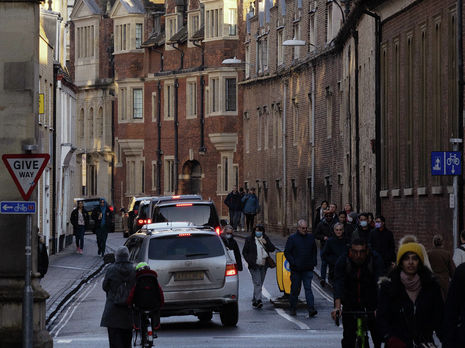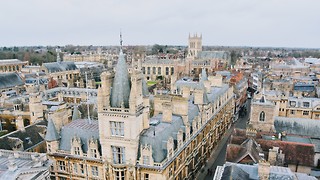Art in Public: Interventions underfoot
Looking down is often the precursor to looking up. Tom Ward transports us to Cambridge’s world of creativity beneath our feet

There aren’t many places that can boast rocket ships, crime scenes and teleporters as attractions, free to visit for all. Yet, as most of us know, Cambridge does: the Dinky Doors are probably some of the city’s best-known works of street art. Quietly nestling around the city are thirteen of these small works, below the line of our gaze and beneath our feet.
“The strength of the Dinky Doors as interventions in urban space isn’t their form. It’s their secrecy”
Walking around the centre of Cambridge, it’s not difficult to stumble across a Dinky Door. Stroll along Downing Street and you’ll see a small black door in the wall with an almost famous number, look a little closer and you’ll see the extruding purple tentacles of its inhabitant. Saunter through the Market Square and you might catch a glimpse of an impressive contraption tucked away between two telephone boxes, complete with tiny text and intricate detailing. Though each door is unique, contingent on the character of its environment, the strength of the Dinky Doors as interventions in urban space isn’t their form. It’s their secrecy.
A quick glance at the Dinky Doors website shows that while there is a map of the broad locations of the doors, there isn’t a guide that explains where to find them: the doors retain an element of secrecy. It’s this obscurity that makes them so successful – there’s something to be said for the thrill of discovery, that illuminating moment when, just out of the corner of your eye, you catch sight of something unusual. In this way, the Dinky Doors re-animate the street as a space of surprise and intrigue: stumbling across a door feels like being let in on a secret, a moment that re-structures our mental map of the city.
“They transform the street from a space of mobility, of hurriedness, into a space of exhibition, of contemplation”
Being attentive to the character of a Dinky Door requires more than just a glance, however. You need to stop, or crouch down, or take a step back to get some perspective. The hidden nature of the doors invites us to become present, to simply look; they transform the street from a space of mobility, of hurriedness, into a space of exhibition, of contemplation. Eschewing the transience of the streetscape, the doors encourage us to use the street not just as a way of going somewhere, but as a way of being – to use the terms of the anthropologist Marc Augé, they encourage us to be bound not in our destination, but in our journey.
Perhaps it is this messiness, of the blurred lines between travelling and being, that inspired some of Dryden Goodwin’s work near the station. Wander is an installation of a hundred discs of steel embedded into the pavements lining Station Place, each disc etched with a portrait of a face. What’s striking about the work is that each portrait is different: different orientations, different visible features, different depths of detail. Walking along the pavement, only a glimpse of each face is caught. One face looks back at you, the hair of the next is obscuring its glance, the next is turning away, upside down even.
“There is poignancy in the fact that we need to look down at our feet to be reminded of the faces around us”
Each day we experience such encounters in the street. We notice the glasses that tall person is wearing, we see that person turn around quickly, their hair tangling in the wind as they do so, we exchange a grin with the person crossing the road. Wander seems to capture the essence of this dichotomy between the transient, anonymous experience of the street and the very humanity that the street depends on; there is poignancy in the fact that we need to look down at our feet to be reminded of the faces around us. Where the Dinky Doors encourage us to think about the urban form of the street, Wander encourages us to notice the people that inhabit it.
Expressing both ideas is, lastly, a work visible when passing into the Downing Site. Antony Gormley’s Earthbound: Plant can be seen in the pavement as a pair of feet, outside the Macdonald Institute for Archaeological Research. Clearly in theme with the building (though inspired by Gormley’s thoughts on burying the self), Earthbound: Plant is a full-size sculpture of a body buried underground. Unassuming and beneath our feet, the work seems to illuminate the street as simultaneously a space of brevity and a space of enduring; only the soles of feet can be seen, only a glimpse of a body protrudes, and yet the body is permanent, rejecting such brevity and embracing an enduring, intangible humanity. Manifesting as exchanged smiles and shy looks, it’s this humanity that sustains the street as a lived place, but, as these interventions make clear, looking down is often the precursor to looking up.
 News / Cambridge academics stand out in King’s 2026 Honours List2 January 2026
News / Cambridge academics stand out in King’s 2026 Honours List2 January 2026 Comment / Plastic pubs: the problem with Cambridge alehouses 5 January 2026
Comment / Plastic pubs: the problem with Cambridge alehouses 5 January 2026 News / Cambridge businesses concerned infrastructure delays will hurt growth5 January 2026
News / Cambridge businesses concerned infrastructure delays will hurt growth5 January 2026 News / AstraZeneca sues for £32 million over faulty construction at Cambridge Campus31 December 2025
News / AstraZeneca sues for £32 million over faulty construction at Cambridge Campus31 December 2025 Interviews / You don’t need to peak at Cambridge, says Robin Harding31 December 2025
Interviews / You don’t need to peak at Cambridge, says Robin Harding31 December 2025









